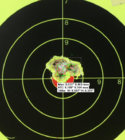dc.fireman
Sling & Irons!
Hey all -
After having a dismal match score last weekend, and some issues with my reloads, I decided to examine again using Varget in my .308 300M match rifle ( a Tikka T3 Sporter), with 1095 rounds fired. I was originally pushing a 168 bullet - Sierra's and Hornady's at an anemic 2400 fps with 40.0 gr. of H4895, seated at 2.800" COAL.
I read a few older threads here regarding 43.5 - 45.0gr. of Varget. I also read several threads proposing the idea of 'convergence', which I still don't quite grasp. Of particular interest to me was a quote by @Erik Cortina regarding not being 'mesmerized by small groups.'
I loaded up groups of four each in 43.5, 43.8, 44.0, 44.2, 44.3, 44.4, 44.5 seated at .050" of the lands (2.920" CAOL), plus 5 rounds of my original load to use as foulers/sighters/baseline. My suspicions were confirmed regarding my original load - it's not even acceptable @ 100Y, much less 300M.
I fired these off at 100 yards, using a 14 power Nikon from a front rest and rear bag - my normal test rig, before switching to iron sights/sling/prone at a 300M reduced for 200Y C-2 target.
Looking at 44.3, it's tough not to be mesmerized - I haven't fired four shots through the same hole, ever.
I have loaded up 30 more of the 44.3 for testing at distance . My question is, what other combinations would you test here, based upon the convergence principle? Change seating depths, and try a charge weight again? Something else?
After having a dismal match score last weekend, and some issues with my reloads, I decided to examine again using Varget in my .308 300M match rifle ( a Tikka T3 Sporter), with 1095 rounds fired. I was originally pushing a 168 bullet - Sierra's and Hornady's at an anemic 2400 fps with 40.0 gr. of H4895, seated at 2.800" COAL.
I read a few older threads here regarding 43.5 - 45.0gr. of Varget. I also read several threads proposing the idea of 'convergence', which I still don't quite grasp. Of particular interest to me was a quote by @Erik Cortina regarding not being 'mesmerized by small groups.'
I loaded up groups of four each in 43.5, 43.8, 44.0, 44.2, 44.3, 44.4, 44.5 seated at .050" of the lands (2.920" CAOL), plus 5 rounds of my original load to use as foulers/sighters/baseline. My suspicions were confirmed regarding my original load - it's not even acceptable @ 100Y, much less 300M.
I fired these off at 100 yards, using a 14 power Nikon from a front rest and rear bag - my normal test rig, before switching to iron sights/sling/prone at a 300M reduced for 200Y C-2 target.
Looking at 44.3, it's tough not to be mesmerized - I haven't fired four shots through the same hole, ever.
I have loaded up 30 more of the 44.3 for testing at distance . My question is, what other combinations would you test here, based upon the convergence principle? Change seating depths, and try a charge weight again? Something else?














